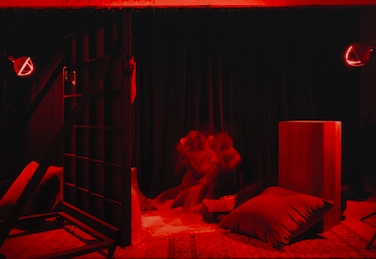Just as Diego Velázquez’s “Las Meninas” (1656) troubled differentiations between life and painting, Paul Mpagi Sepuya confuses the boundaries that separate life and photography, questioning what is intended to be seen and concealed.
In his recent exhibition at Vielmetter Los Angeles, “Daylight Studio / Dark Room Studio,” Sepuya presents two series of photographs that oscillate in scale, light, and technique. The Daylight Studio series depicts the mechanics of the artist’s studio, presenting the studio space as a kind of stage where images are constructed. Historically, the photographer’s “stage” has been a platform of control designed to objectify and dominate marginalized subjects. Alternatively, Sepuya’s studio is a space for play, pleasure, and empowerment where subjects have agency over their bodies and interactions. Sepuya exposes the scaffolding that divides the artist and the subject and conceals the dynamic spaces and relations that animate the studio.
Groups of petite dye-sublimation prints on aluminum depicting the Dark Room Studio are interspersed throughout the gallery. Smaller in scale, their luminous and distorted surfaces require your intimate attention. Entangled figures and streaks of movement are illuminated by red safety lights and captured over a long exposure period. Looking at these images in close proximity, I become self-aware of my own gaze as I peer into seemingly private spaces. Are they dancing? Fucking? Stretching? Maybe it is not for me to know.
Vielmetter Los Angeles
1700 S Santa Fe Ave #101
Los Angeles, CA 90021
On view through October 22, 2022


